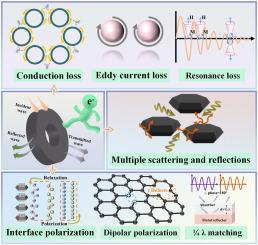LaFe-MOFs derivatives with different compositions for boosting low-frequency and broadband electromagnetic wave absorption
IF 8.2
2区 材料科学
Q1 MATERIALS SCIENCE, MULTIDISCIPLINARY
引用次数: 0
Abstract
To achieve low-frequency and broadband electromagnetic wave absorption (EMWA), building excellent metal-organic frameworks (MOFs)-derived EMWA materials is critical but remains challenging. In this research, La2O3/La2O2CN2/Fe/N-doped carbon (LFC) composites with different compositions were synthesized by adjusting the La3+ content to tune the electromagnetic parameters. As the La3+ content increased, the EMWA performance showed a trend of first increasing and then decreasing. As a result, LFC-2 achieved a minimum reflection loss (RLmin) value of −60.82 dB at a thickness of 2.60 mm when the molar ratio of La3+ to Fe3+ was 1: 1, along with an effective absorption bandwidth value of 5.76 GHz (9.84–15.60 GHz) at 2.29 mm. Moreover, the EMWA performance of LFC-3 at low-frequency (4.08 GHz) was enhanced when the La³⁺ to Fe³⁺ molar ratio was 2: 1, with an RLmin value of −47.47 dB. Comprehensive characterizations suggested that the formation of the La2O2CN2 phase played an indispensable role in optimizing impedance matching and enhancing magnetic loss and dielectric loss. In addition, La3+ had a high coordination number, which effectively regulated the electromagnetic parameters. Concurrently, radar cross-section simulation results confirmed the outstanding EMWA capability of the LFC coating. This work proposed a strategy for LaFe-MOFs derivatives, shedding light on the foundation for designing more efficient low-frequency and broadband absorbent materials.

不同成分的 LaFe-MOFs 衍生物用于提高低频和宽带电磁波吸收率
要实现低频和宽带电磁波吸收(EMWA),构建由金属有机框架(MOFs)衍生的优异电磁波吸收材料至关重要,但仍然具有挑战性。本研究通过调节 La3+ 的含量,合成了不同成分的 La2O3/La2O2CN2/Fe/N 掺杂碳(LFC)复合材料,以调节电磁参数。随着 La3+ 含量的增加,EMWA 性能呈现出先升高后降低的趋势。结果,当 La3+ 与 Fe3+ 的摩尔比为 1:1 时,LFC-2 在厚度为 2.60 mm 时的最小反射损耗(RLmin)值为 -60.82 dB,在 2.29 mm 时的有效吸收带宽值为 5.76 GHz(9.84-15.60 GHz)。此外,当 La³⁺ 与 Fe³⁺ 的摩尔比为 2: 1 时,LFC-3 在低频(4.08 GHz)的 EMWA 性能得到增强,RLmin 值为 -47.47 dB。综合表征结果表明,La2O2CN2 相的形成在优化阻抗匹配、提高磁损耗和介电损耗方面发挥了不可或缺的作用。此外,La3+ 的配位数较高,可有效调节电磁参数。同时,雷达截面模拟结果也证实了 LFC 涂层出色的电磁兼容能力。这项研究提出了 LaFe-MOFs 衍生物的策略,为设计更高效的低频和宽带吸波材料奠定了基础。
本文章由计算机程序翻译,如有差异,请以英文原文为准。
求助全文
约1分钟内获得全文
求助全文
来源期刊

Materials Today Nano
Multiple-
CiteScore
11.30
自引率
3.90%
发文量
130
审稿时长
31 days
期刊介绍:
Materials Today Nano is a multidisciplinary journal dedicated to nanoscience and nanotechnology. The journal aims to showcase the latest advances in nanoscience and provide a platform for discussing new concepts and applications. With rigorous peer review, rapid decisions, and high visibility, Materials Today Nano offers authors the opportunity to publish comprehensive articles, short communications, and reviews on a wide range of topics in nanoscience. The editors welcome comprehensive articles, short communications and reviews on topics including but not limited to:
Nanoscale synthesis and assembly
Nanoscale characterization
Nanoscale fabrication
Nanoelectronics and molecular electronics
Nanomedicine
Nanomechanics
Nanosensors
Nanophotonics
Nanocomposites
 求助内容:
求助内容: 应助结果提醒方式:
应助结果提醒方式:


